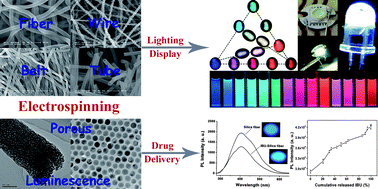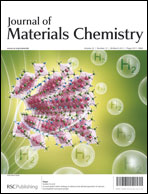This feature article highlights the recent advances on the preparation, characteristics and application of one-dimensional (1D) luminescent materials (including rare earth based inorganic materials, rare earth based composite materials and non rare earth materials) by an electrospinning process. Electrospinning is an effective method to prepare 1D polymer, composite and inorganic submicro- or nano-materials. The key strategy of the electrospinning method is to form an electrospinning solution with viscoelastic behavior similar to that of a conventional polymer solution. It utilizes an electrical force on the surface of an electrospinning solution to overcome the surface tension and produce a very thin charged jet. This jet moves straight for a certain distance, and then bends into looping and spiraling paths. During the elongation of the liquid jet, solvent evaporates and 1D hybrid materials accumulate on a grounded collector. Dispersing complexes or inorganic nanoparticles into polymer and inorganic matrices, composite luminescent materials viaelectrospinning combine both inorganic and organic characters. Annealing the inorganic/polymer hybrid precursors can yield various kinds of inorganic luminescent materials with fiber, wire, belt and tube-like morphologies, which have potential applications in fluorescent lamps and color displays. Furthermore, with the addition of some surfactants, it is possible to prepare 1D luminescent and porous multifunctional materials, which can act as potential drug carriers in the biomedical area.

You have access to this article
 Please wait while we load your content...
Something went wrong. Try again?
Please wait while we load your content...
Something went wrong. Try again?


 Please wait while we load your content...
Please wait while we load your content...